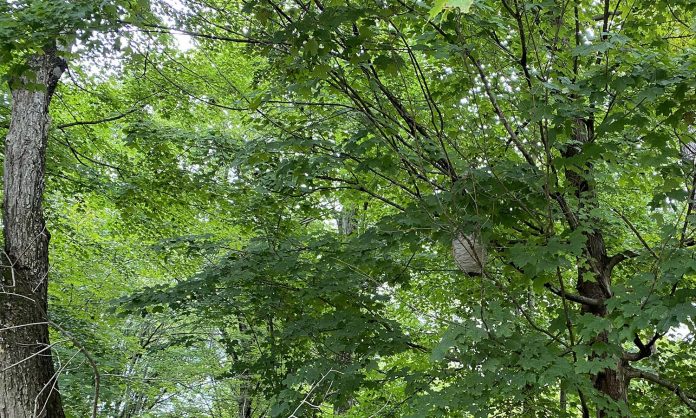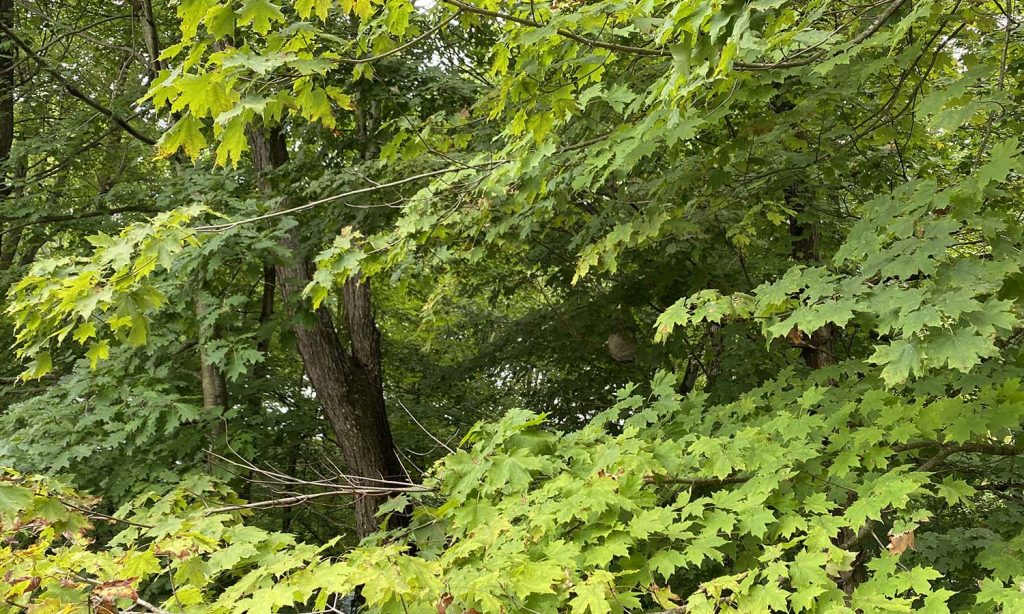
Be on the lookout for large hornet and wasp nests during late summer. Baldfaced hornets, yellowjackets and paper wasps all expand their nests quickly during this time of year. Large nests seemingly appear overnight and they can be a danger to homeowners and their pets.
These nests aren’t new. Wasp and hornet colonies have been building them since spring. Early structures are kept smaller and house fewer individuals. However, over time, colonies expand and so do their nesting structures.
Expansion
Early nests start out small. The beginning of a baldfaced hornet nest measures no more than ½ to 1 inch long. A single queen starts the nest that will house her first round of offspring. It takes about 20-25 days for the larva to emerge as adults.
This process is then repeated throughout the summer and the nest populations begin to increase exponentially as subordinate queens develop. Collectively, the queens lay more eggs, which leads to more workers and larger nests.
Eventually, new queens and males are established within the colonies. New queens are mated and leave the nest in search of overwintering sites. The remaining workers left behind in the nest perish as wasp and hornet nests only last one season.
Late season wasp and hornet behavior
As summer comes to a close, wasps and hornets become more aggressive due to the limited availability of food sources. When the drones and new queens reach maturity in late summer and early fall their nutritional needs shift from a protein-rich diet to a carbohydrate-focused diet. So workers will search for foods that can provide the needed energy boost and oftentimes will come into contact with humans because there are fewer food sources. Soda, donuts, funnel cakes and beer are a few examples of foods and beverages that can attract wasps and hornets in the fall.
Accidental interactions with large nests that are well camouflaged are another reason incidence of wasp and hornet stings increases during this time of year. Large nests mean more individuals hanging out to protect it and an increased likelihood of getting stung.
That’s why it’s important to carefully survey your property and take note of any substantial wasp or hornet nests you find. You shouldn’t try to remove them during this time of year because they are extra aggressive and protective. Avoiding them and making sure your pets keep their distance, as well, is key to reducing your chances of getting stung. Learn how to spot large nests based on the nesting habits of different species.

Identifying large wasp and hornet nests
Yellowjackets. Yellowjackets typically build their nests underground, frequently using the root systems of trees and shrubs to build their nests around. They have also been known to seek some cover for the entrances to their subterranean nests, building them under porches or steps, around railroad ties or in the cracks of sidewalks. Additionally, they will occasionally build nests inside walls or other structures with a sizable void. Midway through the summer, I discovered a yellow jacket nest had been started in the metal tubing of my basketball hoop.
The easiest way to identify yellowjacket nests is by looking for the nest entrance. You’ll notice yellowjackets coming and going and may even see some of them congregating at the opening.
Paper wasps. Paper wasps build umbrella-shaped nests that look like they are made out of paper and contain open, uncovered cells where eggs are laid. These comb nests typically hang from a sheltered area like twigs and branches of trees and shrubs, porch ceilings, the tops of window and doorframes, soffits, eaves, attic rafters, deck floor joists, railings and more.
Baldfaced hornets. Baldfaced hornets build areal nests, typically located out-of-reach and well camouflage. Their paper, cone-shaped nests can be as large as 14 inches in diameter and more than 24 inches long. They are usually built in trees and shrubs; on overhangs and utility poles and in the eaves of houses, sheds and other structures. At their peak, baldfaced hornet colonies consist of 100-400 individuals.

What to do when you’ve found a nest
Wasps and hornets have the ability to sting multiple times without dying. Large nests should always be avoided.
After you’ve discovered a nest you need to mark off the area by placing a sign in the vicinity of the nest without getting too close or by using caution tape to create a buffer zone around the nest.
Avoid doing yard work anywhere near wasp and hornet nests. They feel threatened by the strong vibrations lawn mowers and weed eaters produce. If you found a nest in a location where you typically mow or trim, avoid doing yard work in this area.
You should also keep potential food sources near your house to a minimum and be careful when eating and drinking outdoors to avoid attracting wasps and hornets as food supplies dwindle.
Large nests should be removed during the winter when they’ve gone dormant.










We just recently found a nest hanging low on a tree right below our compost pile. On the other side of the tree is our shed where we keep our lawnmower. Food source and loud sounds, the bald faced hornets couldn’t of picked a worse place in our yard. The nest seemed to of appeared practically over night! Days before we knew the nest was there, the Hornets were kind enough to give a friend in our yard what I would call, warning shots. While unknowingly standing 6 ft. away from the nest, one of them came at my friends nose and what she described as, hitting her at 50 miles an hour. Days after we discovered the nest, my sister was walking in the yard about 20ft. away from the nest and one flew at her at full force and hit her in the arm. Maybe this is a good indication that you may have a nest close by???
If you absolutely need to remove a nest like this you should call the professionals. Thank God, my husband’s technique only got him stung in the arm 3 times.
We just discovered a nest of wasps above front door as we were locking up to leave for a Dr’s appt. Husband got stung. Now we need to get rid of this nuscience before someone else gets stung or who nest attacks.
Help please